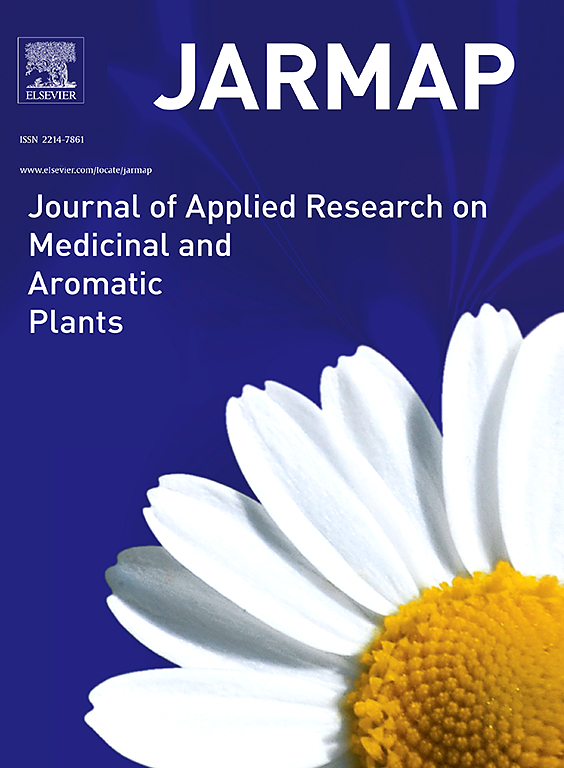Assessment of the quality of plant material in commercial products of ground ivy herb (Glechomae hederaceae herba)
IF 3.6
2区 农林科学
Q1 PLANT SCIENCES
Journal of Applied Research on Medicinal and Aromatic Plants
Pub Date : 2025-04-01
DOI:10.1016/j.jarmap.2025.100634
引用次数: 0
Abstract
G. hederacea has a well-established position in traditional medicinal systems of Europe and Asia. Despite the significant increase in the number of products based on this plant on the European market, there is as yet no European Pharmacopoeia monograph on Glechomae herba, therefore legally binding quality standards of medical-grade ground ivy herb in member states that ratified Convention on the elaboration of a European Pharmacopoeia. This study aimed to investigate differences in the quality of the commercially available single-herb loose G. hederacea products in the aspects of authentication, purity of plant material and content of bioactive substances. As the therapeutic potential of G. hederacea is related to the presence of phenolic compounds, the study on qualitative and quantitative analysis of phenolics by HPLC method was performed. The analysis revealed significant differences in the quality of ground ivy plant material, in terms of the content of bioactive compounds. The determined levels of rosmarinic acid, chlorogenic acid, gallic acid and rutin in the products ranged from 0.10 to 4.55 mg/g DW; 0.18–1.57 mg/g DW; 0.02–1.28 mg/g DW; to 6.01 mg/g DW, respectively. Additionally, the products varied significantly in the sum of determined polyphenols (1.5 – 7.16 mg/g DW). The findings highlight the need to establish the standards and requirements for bioactive phenolic content to ensure high-quality plant material with significant medicinal value. Additionally, our study suggests that rosmarinic acid, rutin, chlorogenic acid, and the total polyphenol content could serve as quality markers for Glechomae hederaceae herba in pro-health applications.
藤属植物商品原料质量评价(英文)
在欧洲和亚洲的传统医药体系中,白头翁有着良好的地位。尽管欧洲市场上以这种植物为基础的产品数量显著增加,但迄今为止还没有关于Glechomae herba的欧洲药典专著,因此,在批准《制定欧洲药典公约》的成员国中,具有法律约束力的医疗级地面常春藤草药质量标准。本研究旨在探讨市售单一药材麻花散装产品在鉴定、原料纯度和生物活性物质含量等方面的质量差异。由于麻属植物的治疗潜力与酚类化合物的存在有关,因此采用高效液相色谱法对麻属植物中的酚类物质进行了定性和定量分析。分析表明,在生物活性化合物含量方面,地面常春藤植物材料的质量存在显著差异。产品中迷迭香酸、绿原酸、没食子酸和芦丁的含量为0.10 ~ 4.55 mg/g DW;0.18 - -1.57 毫克/克DW,0.02 - -1.28 毫克/克DW,分别为6.01 mg/g DW。此外,两种产品的多酚含量差异显著(1.5 - 7.16 mg/g DW)。研究结果表明,有必要建立生物活性酚含量的标准和要求,以确保具有重要药用价值的高质量植物材料。此外,本研究提示迷迭香酸、芦丁、绿原酸和总多酚含量可作为中药的质量评价指标。
本文章由计算机程序翻译,如有差异,请以英文原文为准。
求助全文
约1分钟内获得全文
求助全文
来源期刊

Journal of Applied Research on Medicinal and Aromatic Plants
Pharmacology, Toxicology and Pharmaceutics-Drug Discovery
CiteScore
6.40
自引率
7.70%
发文量
80
审稿时长
41 days
期刊介绍:
JARMAP is a peer reviewed and multidisciplinary communication platform, covering all aspects of the raw material supply chain of medicinal and aromatic plants. JARMAP aims to improve production of tailor made commodities by addressing the various requirements of manufacturers of herbal medicines, herbal teas, seasoning herbs, food and feed supplements and cosmetics. JARMAP covers research on genetic resources, breeding, wild-collection, domestication, propagation, cultivation, phytopathology and plant protection, mechanization, conservation, processing, quality assurance, analytics and economics. JARMAP publishes reviews, original research articles and short communications related to research.
 求助内容:
求助内容: 应助结果提醒方式:
应助结果提醒方式:


